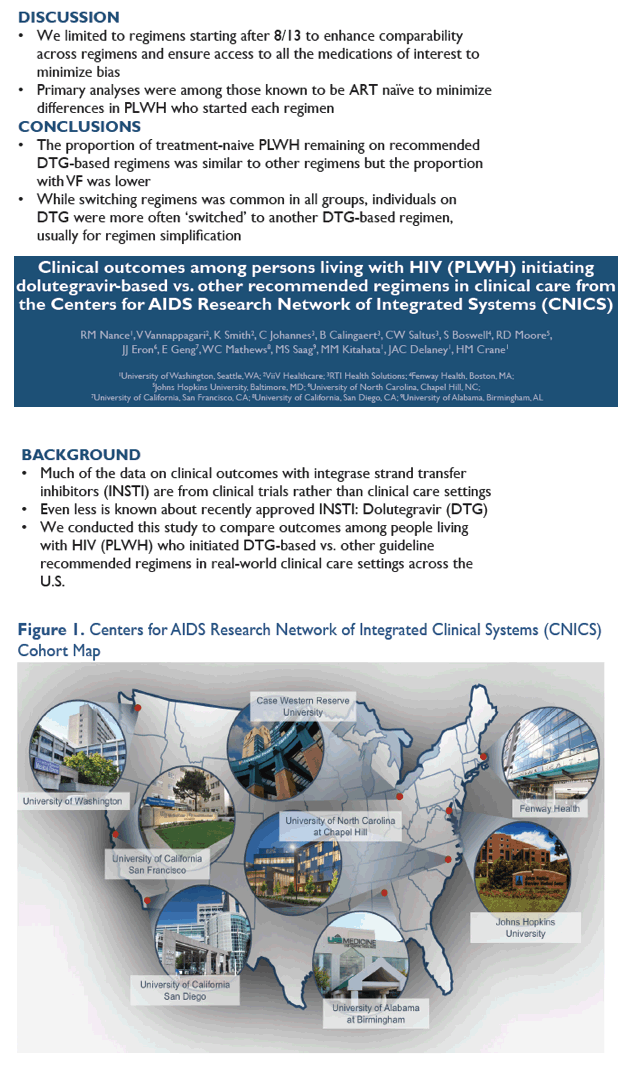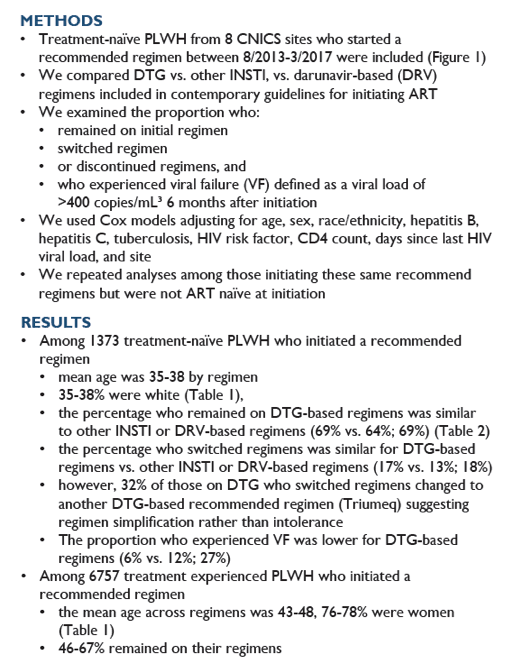 |
 |
 |
| |
Clinical outcomes among persons living with HIV (PLWH) initiating dolutegravir-based vs. other recommended regimens in clinical care from the Centers for AIDS Research Network of Integrated Systems (CNICS)
|
| |
| |
Virologic Failure Rate Lower With DTG Than DRV in Large US Cohort
16th European AIDS Conference, October 25-27, 2017. Milan
Mark Mascolini
People starting or switching to antiretroviral therapy (ART) with dolutegravir (DTG) in a large US cohort ran a lower risk of virologic failure than people starting or switching to boosted darunavir (DRV) [1]. Rates of switching from first-line therapy were similar with DTG, other integrase inhibitors, and DRV, but one third of switches from DTG involved simplification to single-tablet DTG/abacavir/lamivudine (ABC/3TC) (Triumeq).
Researchers working with the Centers for AIDS Research Network of Integrated Systems (CNICS) noted that much research on integrases inhibitors comes from clinical trials, while less is known about outcomes with these potent antiretrovirals in day-to-day practice. This is especially true, the CNICS team noted, with the newest integrase inhibitor, DTG.
To learn more about relative treatment outcomes with DTG, the researchers compared data from 8 CNICS centers involving first-line or later therapy with DTG and other recommended first-line regimens including other integrase inhibitors (raltegravir or elvitegravir) or the boosted protease inhibitor DRV. The analysis included people who started one of these combinations between August 2013 and March 2017. The researchers gathered findings on proportions of cohort members staying on their regimen, switching, stopping, or having virologic failure, defined as a viral load above 400 copies 6 months after starting therapy. To calculate time to virologic failure, the CNICS investigators used Cox models adjusted for age, sex, race/ethnicity, hepatitis B or C, tuberculosis, HIV risk factor, CD4 count, days since last HIV viral load, and study site.
Among 1373 antiretroviral-naive people starting their first antiretrovirals, age averaged 35 to 38 across the three regimens and about one third were white. Average time in care before starting ART was 1.0 year with DTG, 0.6 year with other integrase inhibitors, and 0.9 year with DRV. The DTG group included a lower proportion of men (82%) than the other integrase inhibitor group (88%) or the DRV group (98%).
First-line therapy follow-up averaged 522 days with DTG, 662 days with other integrase inhibitors, and 730 days with DRV. Similar proportions in those three groups--69%, 64%, and 69%--stayed with their initial regimen throughout follow-up. Proportions of switchers were modestly lower with other integrase inhibitors (13%) than with DTG (17%) or DRV (18%). One third of participants (32%) who switched from initial DTG turned to Triumeq, the single-tablet combination of DTG with ABC/3TC.
The proportion of previously untreated CNICS members who had virologic failure was lower with DTG (6%) than with other integrase inhibitors (12%) or DRV (27%). Adjusted analysis linked starting DTG to a 63% lower risk of virologic failure than starting DRV (adjusted hazard ratio [aHR] 0.37, 95% confidence interval [CI] 0.16 to 0.86).
Among the 6757 antiretroviral-experienced people switching to DTG, another integrase inhibitor, or DRV, age averaged 48, 43, and 43, proportions of men were 78%, 78%, and 76%, proportions of whites 46%, 39%, and 29%, and average time in care before starting the new regimen 7.8, 6.0, and 6.1 years. Average baseline CD4 count was lower in the DRV group (428) than in the DTG group (595) or the other integrase inhibitor group (564).
Average days of follow-up were similar with DTG (530), other integrase inhibitors (565), and DRV (547). Higher proportions stayed with DTG (67%) or another integrase inhibitor (62%) throughout follow-up than stayed with DRV (46%). And again virologic failure rates were lower with DTG (5%) than with other integrase inhibitors (9%) or DRV (20%). Adjusted analysis linked switching to DTG to a 40% lower virologic failure risk than switching to DRV (aHR 0.60, 95% CI 0.43 to 0.84).
The CNICS investigators concluded that the proportion of antiretroviral-naive people remaining on a DTG-based regimen was similar to proportions staying with the two other integrase inhibitors or with a DRV-based combination. But significantly lower proportions of naive or experienced people had virologic failure with a DTG regimen than with a DRV regimen. Of course this was not a randomized trial and people starting DRV may have had disadvantages not accounted for in the multivariate analysis.
Reference
1. Nance R, Vannappagari V, Smith K, et al. Clinical outcomes among persons living with HIV (PLWH) initiating dolutegravir-based vs. other recommended regimens in clinical care from the Centers for AIDS Research Network of Integrated Systems (CNICS). 16th European AIDS Conference. October 25-27, 2017. Milan. Abstract PE9/87.
----------------------------
Clinical outcomes among persons living with HIV (PLWH) initiating dolutegravir-based vs. other recommended regimens in clinical care from the Centers for AIDS Research Network of Integrated Systems (CNICS)
EACS - 16TH EUROPEAN AIDS CONFERENCE - MILAN, ITALY Oct 23-25
RM Nance1, V Vannappagari2, K Smith2, C Johannes3, B Calingaert3, CW Saltus3, S Boswell4, RD Moore5,JJ Eron6, E Geng7, WC Mathews8, MS Saag9, MM Kitahata1, JAC Delaney1, HM Crane1
1University of Washington, Seattle, WA; 2ViiV Healthcare; 3RTI Health Solutions; 4Fenway Health, Boston, MA; 5Johns Hopkins University, Baltimore, MD; 6University of North Carolina, Chapel Hill, NC; 7University of California, San Francisco, CA; 8University of California, San Diego, CA; 9University of Alabama, Birmingham, AL



|
| |
|
 |
 |
|
|